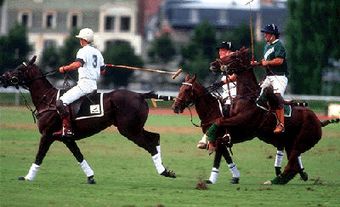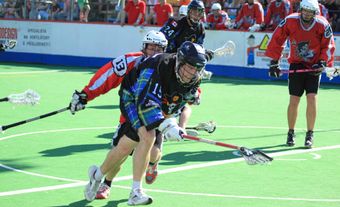Harness Racing
Harness racing, or trotting, is the competition for purse money between horses bred and trained to "trot" or "pace," driven by a driver in coloured silks who is mounted on a 2-wheeled cart called a "sulky." John H. Wallace initiated a registry for gaited horses in 1869 and published The American Trotting Register. Originally horses earned the right to registration by their ability to race in standard record time. The sires and dams and the offspring of these horses then became eligible for registration and became, officially, standardbreds. The Canadian Standardbred Horse Society was formed in 1914 and with permission granted by the federal Department of Agriculture (now Agriculture Canada) undertook the registration and identification of Canadian standardbred horses and published Canadian registers through 1966. At that time records of both Canadian and US records were included in the publications of the United States Trotting Association and Canadian publication was discontinued. The Canadian Trotting Association, formed in 1938, established licensing of racing personnel, rules of racing conduct, and appointed and administered a Canada-wide judges pool until this became the prerogative of individual provincial racing commissions. The CTA was the first to link all tracks under its jurisdiction in a computer network supplying instant results and information. It represented all Canadian provinces except those in the Maritimes, which have historically been a district of the United States Trotting Association. When they were amalgamated in 1998, the Canadian Standardbred Horse Society and The Canadian Trotting Association combined operations as Standardbred Canada. Horses are owned, bred, trained and raced for pleasure and profit by individuals from all walks of life and by corporations, syndicates, breeding farms and partnerships. Familiar as the gentle, tractable, working horse of our agricultural heritage, harness horses are close to the people who work with them; the ownership of a "smart turnout" and a fast horse is a source of pride and pleasure, while fans greet their favourites as old friends. Despite the strong development of professional trainers and drivers, harness racing is unique in that owners are often involved in hands-on work: jogging, training, qualifying, grooming, and often racing their own horses.
Classes of racing are arranged on the basis of age for many stakes and futurities, and also by sex, by money earnings (so that the horses are in competitive groups), or by claiming price, when the owner in effect puts a price tag on his horse. Claiming races enable the horses' interests to classify their own horses so that they can be competitive at whatever level they are priced. Thus, the opportunity to do well is offered to horses from superstars to slower performers. A labour-intensive industry, the many thousands that are employed full time include both men and women, young and old, affluent and poor, both the educated and illiterate, professional and amateur or those who spend part of their time purely for the pleasure that the "hands-on" involvement with their own horse provides. Increasingly these numbers are the army of professionals and suppliers who service the industry-from the farms who supply the feed to the veterinarians and blacksmiths, to the manufacturers of sulkies, harness and horseshoes, trucks and trailers, medications and blankets.
Racetracks are operated by private owners, by exhibition and fair associations, by corporations, and even by fraternal and charitable organizations. They offer a wide range of facilities from summer-only tracks to sophisticated sports-palace types with fine dining and club facilities, or all-weather tracks and permanent stabling for a thousand or more horses, providing original drama being played out every day of the year. Canadians are expert horsemen and hold many of the immortal records of the sport. Consistently more than half of the top 10 North American drivers each year have been native Canadians. Dave McClary of London, Ont, drove the first 2-minute mile (1.6 km) with a standardbred (1898). Clint Galbraith drove the first 1.50 mile with Niatross. John Campbell of Ailsa Craig, Ont, has accomplished more 2-minute miles than any other driver in the history of the sport, and holds the record for the largest amount of purse money won, currently in excess of 175 million dollars. Ben White of Whitevale, Ont, was the first to win the Hambletonian Stakes 4 times. In 1981, he was the first Canadian to take horses to Florida for winter training and was instrumental in establishing a Florida training establishment named for him. William O'Donnell of Springhill, NS, became the first to exceed $4 million in yearly winnings. Herve Filion of Angers, Qué, has won more harness races than any other driver. Filion was the first driver to win 400 races in a season and has won the leading driver award over 15 times. Michael Lachance of St.-Augustine, Qué, has won the title 4 times, including the first 700-win season in 1986. That was Lachance's third straight year to win the North American title. Marie Hill immortalized the consummate horseman, Joe O'Brien, a native of Prince Edward Island, in her book Gentleman Joe, and the impressive yearly harness honours are named The O'Brien Awards in his honour. Canadian breeders have attained international reputations and their co-operative efforts have established important sire stakes programs that have resulted in larger purses, competitive racing, and investment in improved breeding stock. Great Canadian-owned horses include Tacony, the first Canadian-bred world champion (1853); Gratton Bars, the first to win the top 3 pacing stakes in North America-all in one 3-week period of 1928; Jade Prince, the first 2-year-old world champion pacer (1976); Cam Fella, who closed out a sensational career with 28 straight victories (1983); and Niatross, the first standardbred to break the 1:50 barrier with a 1:49.1 time trial, followed by his outstanding carrier as a stallion.
Once the only legal gambling venue, betting was originally conducted by bookies and betting pools, and is now conducted only through pari-mutuels. Harness racing consistently recorded the highest yearly attendance of any sport until the introduction of competitive forms of legal gambling by all sports betting, lotteries and casinos eroded the traditional base. Canadian tracks were first to respond with free admission and parking, and 1999 saw the first slot machines at racetracks, as a growing network of off-track betting outlets carry the racing programs.
The Canadian Sportsman is the oldest continuously published harness magazine in North America. An almost unlimited source of harness news and information is available on the Internet as harness organizations, tracks, breeders and horsemen maintain Internet sites.

 Share on Facebook
Share on Facebook Share on X
Share on X Share by Email
Share by Email Share on Google Classroom
Share on Google Classroom


